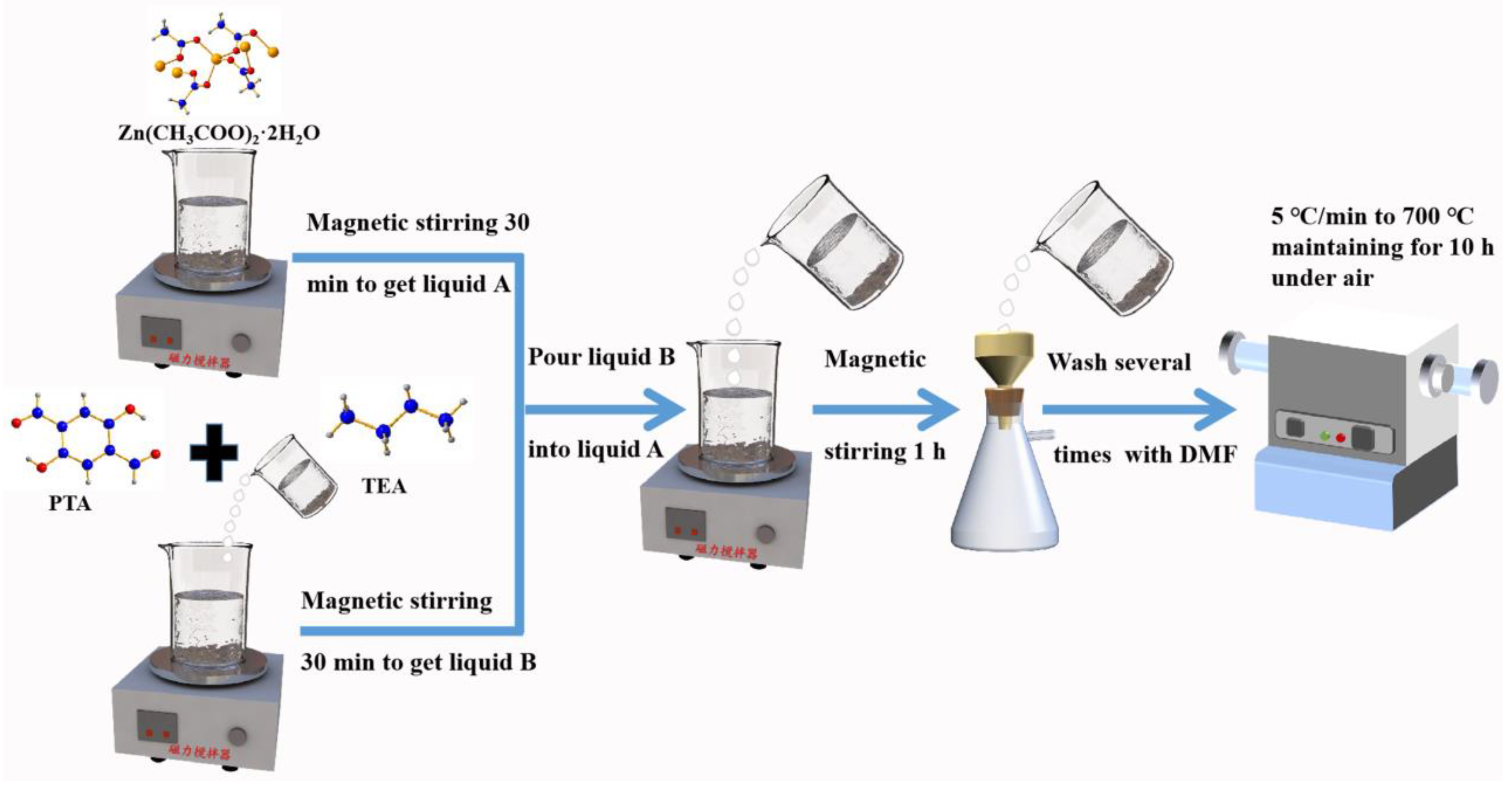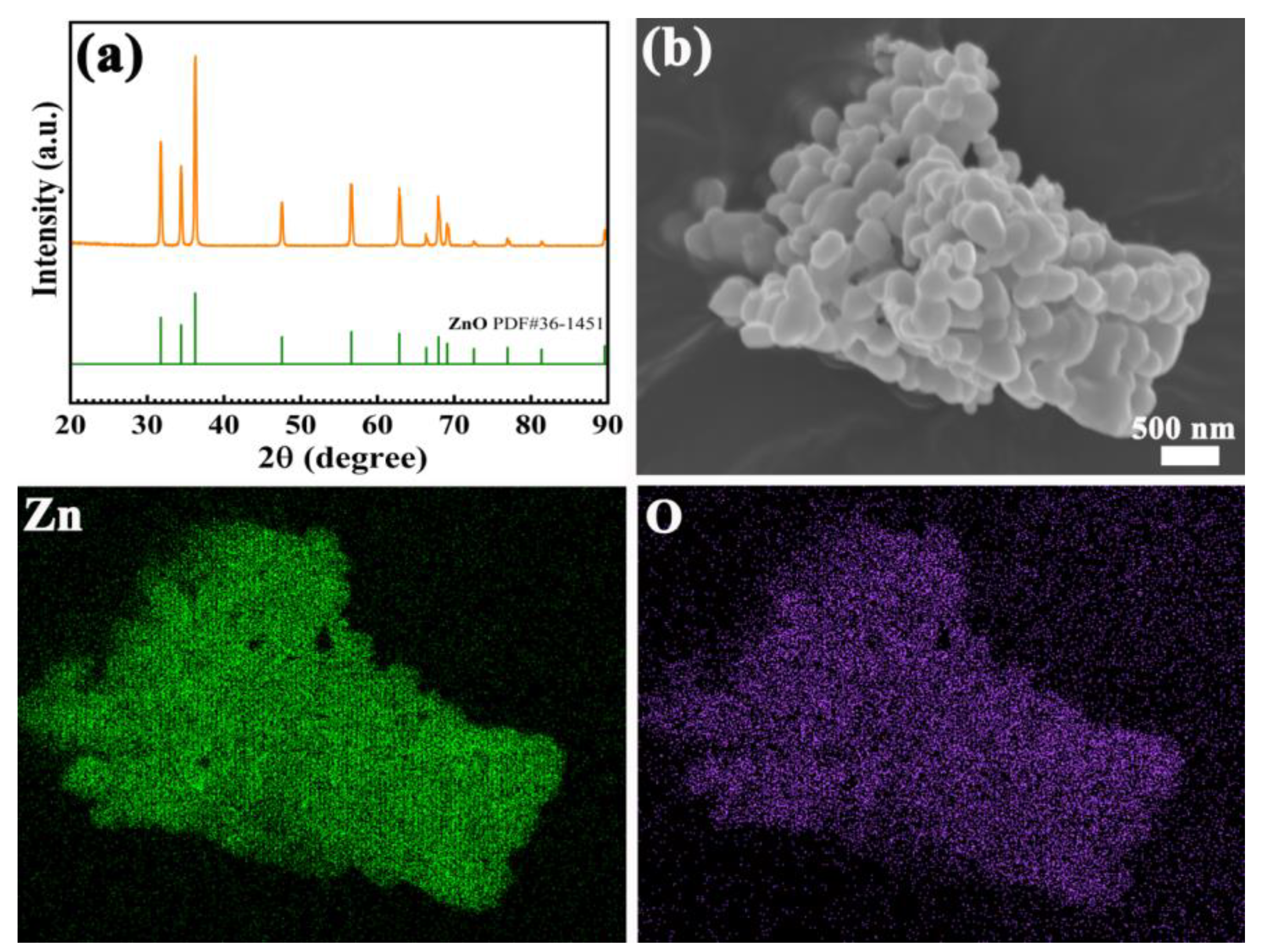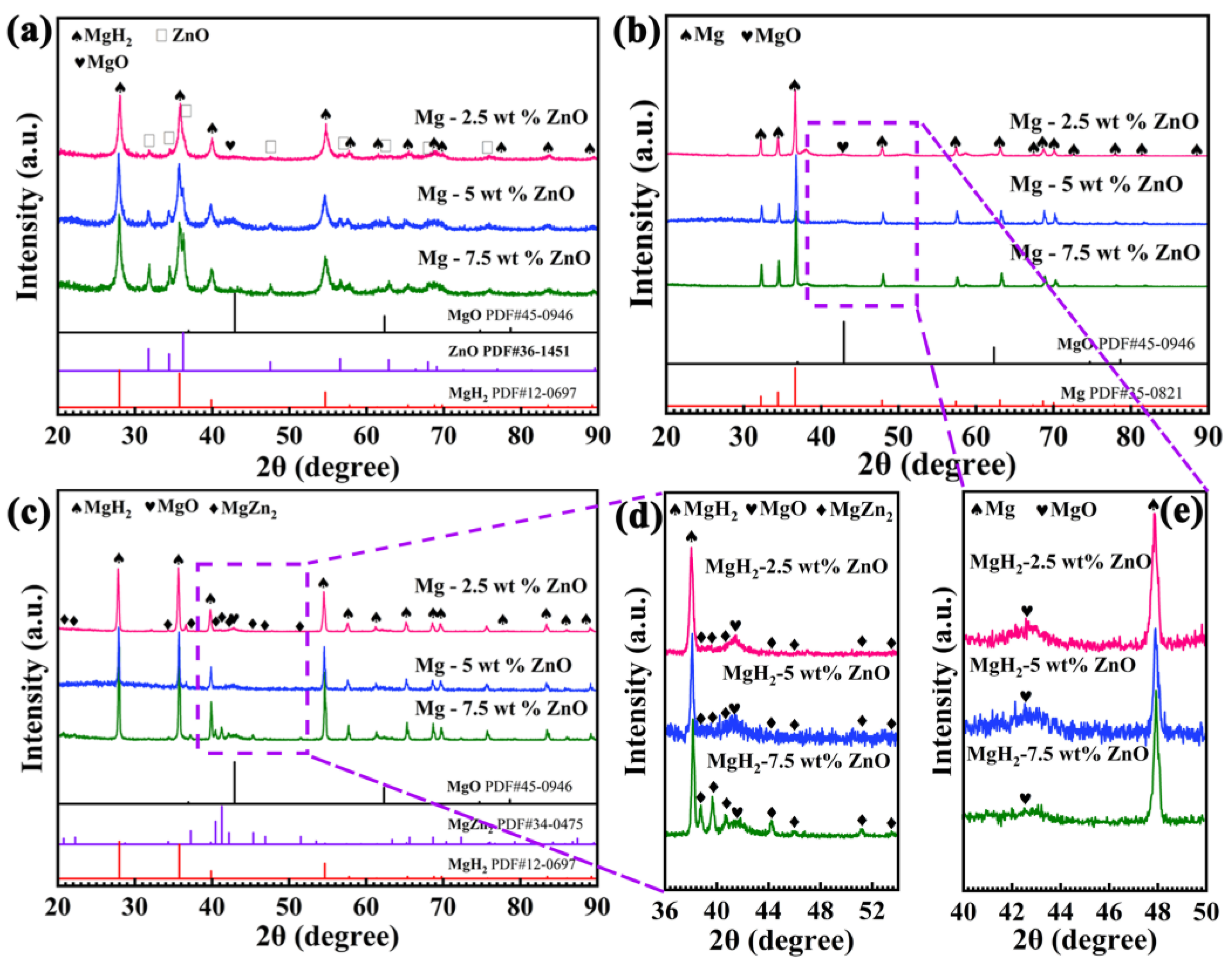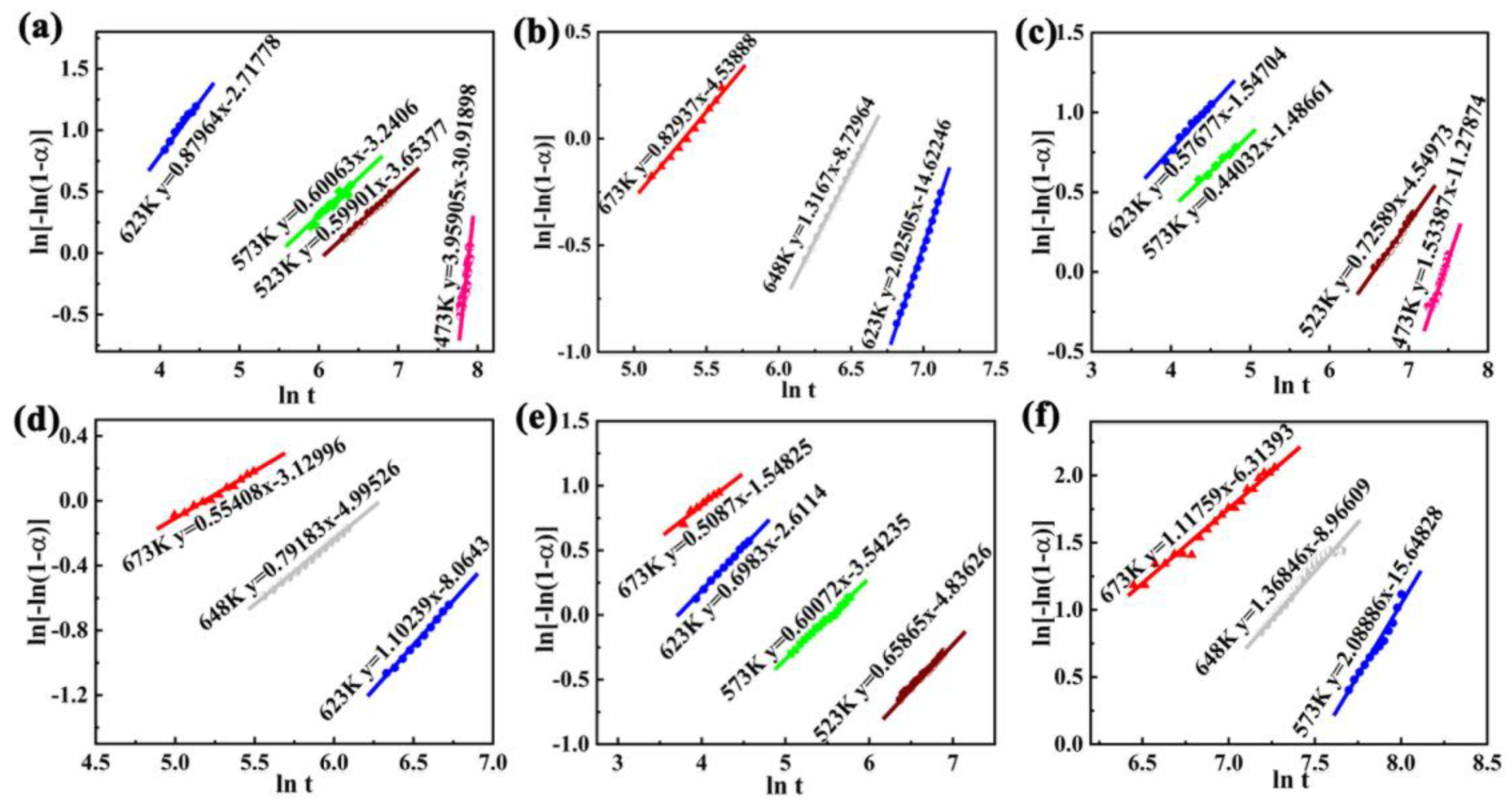Phase Transformation and Performance of Mg-Based Hydrogen Storage Material by Adding ZnO Nanoparticles
Abstract
:1. Introduction
2. Materials and Methods
2.1. Materials
2.2. Preparation of the ZnO
2.3. Preparation of the MgH2-xZnO Nanocomposites (x = 2.5, 5, 7.5 wt%)
2.4. Characterization
3. Results and Discussion
3.1. Characterization of ZnO
3.2. Characterization of MgH2-xZnO Composite (x = 2.5, 5, 7.5 wt%)
3.3. Microstructure of MgH2-xZnO (x = 2.5, 5, 7.5 wt%)
4. Conclusions
Author Contributions
Funding
Data Availability Statement
Conflicts of Interest
References
- Hu, M.M.; Xie, X.B.; Chen, M.; Zhu, C.X.; Liu, T. TiCX-decorated Mg nanoparticles confined in carbon shell: Preparation and catalytic mechanism for hydrogen storage. J. Alloys Compd. 2020, 817, 152813. [Google Scholar] [CrossRef]
- Zhao, Y.Y.; Zhu, Y.F.; Liu, J.C.; Ma, Z.L.; Zhang, J.G.; Liu, Y.N.; Li, Y.H.; Li, L.Q. Enhancing hydrogen storage properties of MgH2 by core-shell CoNi@ C. J. Alloys Compd. 2021, 862, 158004. [Google Scholar] [CrossRef]
- Liu, J.; Zhang, X.; Li, Q.; Chou, K.; Xu, K. Investigation on kinetics mechanism of hydrogen absorption in the La2Mg17-based composites. Int. J. Hydrogen Energy 2009, 34, 1951–1957. [Google Scholar] [CrossRef]
- Neto, G.R.A.; Beatrice, C.A.G.; Leiva, D.R.; Pessan, L.A. Polyetherimide-LaNi5 composite films for hydrogen storage applications. Int. J. Hydrogen Energy 2021, 46, 23767–23778. [Google Scholar] [CrossRef]
- Liu, W.; Francois, K.; Zinsou, A. Low temperature synthesis of LaNi5 nanoparticles for hydrogen storage. Int. J. Hydrogen Energy 2016, 41, 1679–1687. [Google Scholar] [CrossRef]
- Calizzi, M.; Chericoni, D.; Jepsen, L.H.; Jensen, T.R.; Pasquini, L. Mg-Ti nanoparticles with superior kinetics for hydrogen storage. Int. J. Hydrogen Energy 2016, 41, 14447–14454. [Google Scholar] [CrossRef]
- Majid, N.A.A.; Maeda, N.; Notomi, M. Improved hydrogen desorption properties of magnesium hydride with TiFe0. 8Mn0. 2, graphite and iron addition. Int. J. Hydrogen Energy 2019, 44, 29189–29195. [Google Scholar] [CrossRef]
- Yartys, V.A.; Lototskyy, M.V. Laves type intermetallic compounds as hydrogen storage materials: A review. J. Alloys Compd. 2022, 916, 165219. [Google Scholar] [CrossRef]
- Dagher, A.; Salem, H.G.; Moustafa, T.M.; Mettawee, E.B.; Rahman, E.A. Hydrogen absorption characteristics of mechanically alloyed Ti–Zr–Ni and Ti–V–Ni powders. Int. J. Hydrogen Energy 2014, 39, 17740–17746. [Google Scholar] [CrossRef]
- Balcerzak, M. Structural, electrochemical and hydrogen sorption studies of nanocrystalline Ti-V-Co and Ti-V-Ni-Co alloys synthesized by mechanical alloying method. J. Mater. Eng. Perform. 2019, 28, 4838–4844. [Google Scholar] [CrossRef] [Green Version]
- Xie, X.B.; Ma, X.J.; Liu, P.; Shang, J.X.; Li, X.G.; Liu, T. Formation of multiple-phase catalysts for the hydrogen storage of Mg nanoparticles by adding flowerlike NiS. ACS Appl. Mater. Interfaces 2017, 9, 5937–5946. [Google Scholar] [CrossRef] [PubMed]
- Peng, D.D.; Zhang, Y.; Han, S.M. Fabrication of multiple-phase magnesium-based hydrides with enhanced hydrogen storage properties by activating NiS@ C and Mg powder. ACS Sustain. Chem. Eng. 2021, 9, 998–1007. [Google Scholar] [CrossRef]
- Xie, X.B.; Li, Y.C.; Chen, M.; Hu, M.M.; Feng, Y.X.; Shang, J.X.; Liu, T. Catalytic effects of decorating AlV3 nanocatalyst on hydrogen storage performance of Mg@Mg17Al12 nanocomposite: Experimental and theoretical study. ACS Sustain. Chem. Eng. 2020, 8, 4920–4930. [Google Scholar] [CrossRef]
- Liu, B.; Zhang, B.; Chen, X.; Lv, Y.; Huang, H.; Yuan, J.; Lv, W.; Wu, Y. Remarkable enhancement and electronic mechanism for hydrogen storage kinetics of Mg nano-composite by a multi-valence Co-based catalyst. Mater. Today Nano 2022, 17, 100168. [Google Scholar] [CrossRef]
- Lv, Y.J.; Wu, Y. Current research progress in magnesium borohydride for hydrogen storage (A review). Prog. Nat. Sci. Mater. Int. 2021, 31, 809–820. [Google Scholar] [CrossRef]
- Zhang, Q.Y.; Huang, Y.K.; Ma, T.C.; Li, K.; Ye, F.; Wang, X.C.; Jiao, L.F.; Yuan, H.T.; Wang, Y.J. Facile synthesis of small MgH2 nanoparticles confined in different carbon materials for hydrogen storage. J. Alloys Compd. 2020, 825, 153953. [Google Scholar] [CrossRef]
- Xie, X.B.; Chen, M.; Liu, P.; Shang, J.X.; Liu, T. High hydrogen desorption properties of Mg-based nanocomposite at moderate temperatures: The effects of multiple catalysts in situ formed by adding nickel sulfides/graphene. J. Power Source 2017, 371, 112–118. [Google Scholar] [CrossRef]
- Gao, H.G.; Shi, R.; Zhu, J.L.; Liu, Y.N.; Shao, Y.T.; Zhu, Y.F.; Zhang, J.G.; Li, L.Q.; Hu, X.H.; Li, L.Q.; et al. One-step self-assembly of TiO2/MXene heterostructures for improving the hydrogen storage performance of magnesium hydride. J. Alloys Compd. 2021, 564, 150302. [Google Scholar] [CrossRef]
- Fu, Y.K.; Zhang, L.; Li, Y.; Guo, S.Y.; Yu, H.; Wang, W.F.; Ren, K.L.; Zhang, W.; Han, S.M. Catalytic effect of MOF-derived transition metal catalyst FeCoS@C on hydrogen storage of magnesium. J. Mater. Sci. Technol. 2023, 138, 59–69. [Google Scholar] [CrossRef]
- Ma, Z.W.; Panda, S.; Zhang, Q.Y.; Sun, F.Z.; Khan, D.; Ding, W.J.; Zou, J.X. Improving hydrogen sorption performances of MgH2 through nanoconfinement in a mesoporous CoS nano-boxes scaffold. Chem. Eng. J. 2021, 406, 126790. [Google Scholar] [CrossRef]
- Liu, J.C.; Liu, Y.N.; Liu, Z.B.; Ma, Z.L.; Ding, Y.J.; Zhu, Y.F.; Zhang, Y.; Zhang, J.G.; Li, L.Q. Effect of rGO supported NiCu derived from layered double hydroxide on hydrogen sorption kinetics of MgH2. J. Alloys Compd. 2019, 789, 768–776. [Google Scholar] [CrossRef]
- Ismail, M.; Yahya, M.S.; Sazelee, N.A.; Ali, N.A.; HalimYap, F.A.; Mustaf, N.S. The effect of K2SiF6 on the MgH2 hydrogen storage properties. J. Magnes. Alloys 2020, 8, 832. [Google Scholar] [CrossRef]
- Xie, X.B.; Chen, M.; Hu, M.M.; Liu, T. Recoverable Ni2Al3 nanoparticles and their catalytic effects on Mg-based nanocomposite during hydrogen absorption and desorption cycling. Int. J. Hydrogen Energy 2018, 43, 21856–21863. [Google Scholar] [CrossRef]
- Lin, H.J.; Tang, J.J.; Yu, Q.; Wang, H.; Ouyang, L.Z.; Zhao, Y.J.; Liu, J.W.; Wang, W.H.; Zhu, M. Symbiotic CeH2.73/CeO2 catalyst: A novel hydrogen pump. Nano Energy 2014, 9, 80–87. [Google Scholar] [CrossRef]
- Pan, S.X.; Zhang, J.; Zhou, X.J.; Jin, R.S.; He, J.H.; Chen, J.N.; Lu, X.Z.; Chen, X.M. Investigation on hydrogen storage properties of as-cast, extruded and swaged Mg-Y-Zn alloys. Int. J. Hydrogen Energy 2022, 47, 34545–34554. [Google Scholar] [CrossRef]
- Wang, Y.Q.; Zhou, Z.Y.; Zhou, W.Z.; Xu, L.Q.; Guo, J.; Lan, Z.Q. Effects of in-situ formed Mg2Si phase on the hydrogen storage properties of MgLi solid solution alloys. Mater. Des. 2016, 111, 248–252. [Google Scholar] [CrossRef]
- Ali, N.A.; Ismail, M. Advanced hydrogen storage of the Mg-Na-Al system: A review. J. Magnes. Alloys 2021, 9, 1111–1122. [Google Scholar] [CrossRef]
- Du, J.Q.; Lan, Z.Q.; Zhang, H.; Lü, S.X.; Liu, H.Z.; Guo, J. Catalytic enhanced hydrogen storage properties of Mg-based alloy by the addition of reduced graphene oxide supported V2O3 nanocomposite. J. Alloys Compd. 2019, 802, 660–667. [Google Scholar] [CrossRef]
- Zhang, X.; Leng, Z.H.; Gao, M.X.; Hu, J.J.; Du, F.; Yao, J.H.; Pan, H.G.; Liu, Y.F. Enhanced hydrogen storage properties of MgH2 catalyzed with carbon-supported nanocrystalline TiO2. J. Power Source 2018, 398, 183–192. [Google Scholar] [CrossRef]
- Song, M.Y.; Kwon, S.N.; Park, H.R.; Mumm, D.R. Effects of fine Cr2O3 addition on Mg's hydrogen-storage performance J. Ind. Eng. Chem. 2011, 17, 167–169. [Google Scholar] [CrossRef]
- Zhong, D.P.; Pei, G.S.; Kang, J.L.; Xiang, J.Y.; Pan, C.; Gu, W.A.; Lv, X.W.; Li, L.J. Synthesis of vanadium powder by magnesiothermic reduction of V2O3 in a reactive molten salt. J. Iron Steel Res. Int. 2022, 1–10. [Google Scholar] [CrossRef]
- Song, M.Y.; Kwon, S.N.; Bobet, J.L.; Park, H.R. Enhancement of hydrogen-storage properties of Mg by reactive mechanical grinding with oxide, metallic element (s), and hydride-forming element. Ceram. Int. 2011, 37, 897–902. [Google Scholar] [CrossRef]
- Liu, G.H.; Wang, L.X.; Hua, Y.W.T.; Sun, C.H.; Leng, H.Y.; Li, Q.; Wu, C.Z. Enhanced catalytic effect of TiO2@ rGO synthesized by one-pot ethylene glycol-assisted solvothermal method for MgH2. J. Alloys Compd. 2021, 881, 160644. [Google Scholar] [CrossRef]
- Chen, B.H.; Chuang, Y.S.; Chen, C.K. Improving the hydrogenation properties of MgH2 at room temperature by doping with nano-size ZrO2 catalyst. J. Alloys Compd. 2016, 655, 83–842. [Google Scholar] [CrossRef]
- Chuang, Y.S.; Wang, H.S.J. Synthesis and hydrogen absorption/desorption properties of Mg-Nb2O5-SWCNT/MWCNT nanocomposite prepared by reactive milling. J. Alloys Compd. 2016, 656, 21–27. [Google Scholar] [CrossRef]
- Zhong, H.C.; Xu, J.B. Tuning the de/hydriding thermodynamics and kinetics of Mg by mechanical alloying with Sn and Zn. Int. J. Hydrogen Energy 2019, 44, 2926–2933. [Google Scholar] [CrossRef]
- Deledda, S.; Hauback, B.C.; Fjellvag, H. H-sorption behavior of mechanically activated Mg-Zn powders. J. Alloys Compd. 2007, 446–447, 173–177. [Google Scholar] [CrossRef]
- Liu, T.; Zhang, T.W.; Zhang, X.Z.; Li, X.G. Synthesis and hydrogen storage properties of ultrafine Mg-Zn particles. Int. J. Hydrogen Energy 2011, 36, 3515–3520. [Google Scholar] [CrossRef]
- Sahlberg, M.; Andersson, Y. Hydrogen absorption in Mg-Y-Zn ternary compounds. J. Alloys Compd. 2007, 446–447, 134–137. [Google Scholar] [CrossRef]
- Zhang, B.; Xie, X.B.; Wang, Y.K.; Hou, C.X.; Sun, X.Q.; Zhang, Y.P.; Yang, X.Y.; Yu, R.H.; Du, W. In situ formation of multiple catalysts for enhancing the hydrogen storage of MgH2 by adding porous Ni3ZnC0.7/Ni loaded carbon nanotubes microspheres. J. Magnes. Alloys 2022. [Google Scholar] [CrossRef]
- Mustafa, N.S.; Ismail, M. Hydrogen sorption improvement of MgH2 catalyzed by CeO2 nanopowder. J. Alloys Compd. 2017, 695, 2532–2538. [Google Scholar] [CrossRef]
- Milosevic, S.; Kurko, S.; Pasquini, L.; Matovic, L.; Vujasin, R.; Novakovic, N.; Novakovic, J.G. Fast hydrogen sorption from MgH2-VO2 (B) composite materials. J. Power Source 2016, 307, 481–488. [Google Scholar] [CrossRef]
- Ren, S.Q.; Fu, Y.K.; Zhang, L.; Cong, L.; Xie, Y.C.; Yu, H.; Wang, W.F.; Li, Y.; Jian, L.; Wang, Y. An improved hydrogen storage performance of MgH2 enabled by core-shell structure Ni/Fe3O4@MIL. J. Alloys Comp. 2021, 892, 162048. [Google Scholar] [CrossRef]
- Singh, R.K.; Sadhasivam, T.; Sheeja, G.I.; Singh, P.; Srivastava, O.N. Effect of different sized CeO2 nano particles on decomposition and hydrogen absorption kinetics of magnesium hydride. Int. J. Hydrogen Energy 2013, 38, 6221–6225. [Google Scholar] [CrossRef]










| The Hydrogenation of the ln [−ln(1−α)] vs. lnt Equation and the Standard Deviation | The Dehydrogenation of the ln [−ln(1−α)] vs. lnt Equation and the Standard Deviation | |||
|---|---|---|---|---|
| MgH2-2.5 wt% ZnO | 623 K: y = 0.87964x − 2.71778 573 K: y = 0.60063x − 3.2406 523 K: y = 0.59901x − 3.65377 473 K: y = 3.95905x − 30.91898 | SD = 0.01835 SD = 0.00538 SD = 0.00183 SD = 0.07303 | 673 K: y = 0.82937x − 4.53888 648 K: y = 1.3167x − 8.72964 623 K: y = 2.02505x − 14.62246 | SD = 0.01383 SD = 0.00268 SD = 0.01026 |
| Eab = 72.00 KJ/mol | Ede = 107.58 KJ/mol | |||
| MgH2−5.0 wt% ZnO | 623 K: y = 0.57677x − 1.54704 573 K: y = 0.44032x − 1.48661 523 K: y = 0.72589x − 4.54973 473 K: y = 1.53387x−11.27874 | SD = 0.01784 SD = 0.00950 SD = 0.01053 SD = 0.03496 | 673 K: y = 0.55408x − 3.12996 648 K: y = 0.79183x − 4.99526 623 K: y = 1.10239x − 8.0643 | SD = 0.00978 SD = 0.00451 SD = 0.01028 |
| Eab = 82.66 KJ/mol | Ede = 116.35 KJ/mol | |||
| MgH2−7.5 wt% ZnO | 673 K: y = 0.5087x − 1.54825 623 K: y = 0.6983x − 2.6114 573 K: y = 0.60072x − 3.54235 523 K: y = 0.65865x − 4.83626 | SD = 0.02310 SD = 0.00728 SD = 0.00976 SD = 0.00971 | 673 K: y = 1.11759x − 6.31393 648 K: y = 1.36846x − 8.96609 623 K: y = 2.08886x − 15.64828 | SD = 0.03828 SD = 0.04221 SD = 0.03016 |
| Eab = 88.43 KJ/mol | Ede = 128.41 KJ/mol | |||
Disclaimer/Publisher’s Note: The statements, opinions and data contained in all publications are solely those of the individual author(s) and contributor(s) and not of MDPI and/or the editor(s). MDPI and/or the editor(s) disclaim responsibility for any injury to people or property resulting from any ideas, methods, instructions or products referred to in the content. |
© 2023 by the authors. Licensee MDPI, Basel, Switzerland. This article is an open access article distributed under the terms and conditions of the Creative Commons Attribution (CC BY) license (https://creativecommons.org/licenses/by/4.0/).
Share and Cite
Zhang, B.; Liu, R.; Kimura, H.; Dou, Y.; Dai, Z.; Xiao, L.; Ni, C.; Hou, C.; Sun, X.; Yu, R.; et al. Phase Transformation and Performance of Mg-Based Hydrogen Storage Material by Adding ZnO Nanoparticles. Nanomaterials 2023, 13, 1321. https://doi.org/10.3390/nano13081321
Zhang B, Liu R, Kimura H, Dou Y, Dai Z, Xiao L, Ni C, Hou C, Sun X, Yu R, et al. Phase Transformation and Performance of Mg-Based Hydrogen Storage Material by Adding ZnO Nanoparticles. Nanomaterials. 2023; 13(8):1321. https://doi.org/10.3390/nano13081321
Chicago/Turabian StyleZhang, Bing, Ronghan Liu, Hideo Kimura, Yuming Dou, Ziyin Dai, Lirong Xiao, Cui Ni, Chuanxin Hou, Xueqin Sun, Ronghai Yu, and et al. 2023. "Phase Transformation and Performance of Mg-Based Hydrogen Storage Material by Adding ZnO Nanoparticles" Nanomaterials 13, no. 8: 1321. https://doi.org/10.3390/nano13081321






